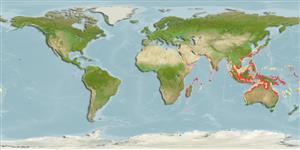Common names from other countries
>
Ovalentaria/misc (Various families in series Ovalentaria) >
Ambassidae (Asiatic glassfishes)
Etymology: Ambassis: Derived from Greek, anabasis = climbing up (Ref. 45335).
More on author: Cuvier.
Environment: milieu / climate zone / depth range / distribution range
Ecología
marino; agua dulce; salobre demersal. Tropical
Distribución
Países | Áreas FAO | Ecosistemas | Ocurrencias, apariciones | Point map | Introducciones | Faunafri
Indo-West Pacific from Algoa Bay in South Africa, north to the Red Sea, Seychelles, and eastward around India and Australasia to the Philippines and China (Ref. 50956).
Tamaño / Peso / Age
Maturity: Lm ? range ? - ? cm
Max length : 10.0 cm SL macho / no sexado; (Ref. 52193)
Short description
Claves de identificación | Morfología | Morfometría
Espinas dorsales (total) : 7 - 8; Radios blandos dorsales (total) : 8 - 10; Espinas anales: 3; Radios blandos anales: 8 - 11. Diagnosis: Ambassis dussumieri has the following combination of characters: supraorbital spines 1-5, usually 3-4; rostral spine present; rear margin of preopercle smooth (at least dorsally); interopercle edge smooth; two rows of cheek scales; predorsal scales 13-16; lateral line discontunuous; lower gill rakers 22-25; pectoral-fin rays 14-16 (Ref. 50956).
Occurs in estuarian and coastal areas but also in freshwaters (Ref. 57749). Generally occurs in the seas and estuaries, but also found in rivers within tidal influence (Ref. 4833). Also Ref. 43640.
Life cycle and mating behavior
Maturities | Reproducción | Spawnings | Egg(s) | Fecundities | Larva
Maugé, L.A., 1986. Ambassidae. p. 297-298. In J. Daget, J.-P. Gosse and D.F.E. Thys van den Audenaerde (eds.) Check-list of the freshwater fishes of Africa (CLOFFA). ISNB, Brussels; MRAC, Tervuren; and ORSTOM, Paris. Vol. 2. (Ref. 4180)
IUCN Red List Status (Ref. 130435)
CITES (Ref. 128078)
Not Evaluated
Threat to humans
Harmless
Human uses
Pesquerías: sin interés
Herramientas
Special reports
Download XML
Fuentes de Internet
Estimates based on models
Preferred temperature (Ref.
115969): 24.6 - 29, mean 28 (based on 1014 cells).
Phylogenetic diversity index (Ref.
82804): PD
50 = 0.5000 [Uniqueness, from 0.5 = low to 2.0 = high].
Bayesian length-weight: a=0.01230 (0.00515 - 0.02940), b=3.01 (2.82 - 3.20), in cm Total Length, based on LWR estimates for this Genus-body shape (Ref.
93245).
Nivel trófico (Ref.
69278): 3.4 ±0.4 se; based on size and trophs of closest relatives
Resiliencia (Ref.
120179): Alto, población duplicada en un tiempo mínimo inferior a 15 meses (Preliminary K or Fecundity.).
Fishing Vulnerability (Ref.
59153): Low vulnerability (10 of 100).
